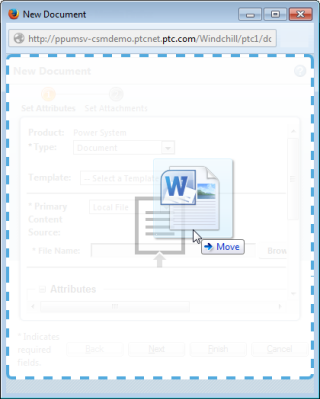• Click the new document icon  on the Folder Contents table toolbar or select > from the table Actions menu.
on the Folder Contents table toolbar or select > from the table Actions menu.
You can create Windchill documents by dragging and dropping one or more files over the Folder Contents table. However, the New Multiple Documents window opens even when you drop a single file. You cannot add attachments from the New Multiple Documents window. For more information, see Creating Multiple Documents. |
If an organization identifier field appears, select an organization identifier, such as a CAGE code or DUNS number, with which you will associate the documents. |
Primary Content Source | Description | ||
No Content | A document without content (for example, a placeholder for future documentation).
| ||
Local File | A file uploaded from your local machine. Click Browse to select a file on your local machine. You can also drag and drop a file to upload it: a. Open a folder browser or resize the Windchill windows so that you can view your desktop. Select the file you want to upload. b. Click and drag the file to the Windchill action window and then release:  For more information, see About Drag-and-Drop.
| ||
URL Link | A link to an external website. URL—The full URL of the website to which you are linking. URL Label—A shortened name to identify the link. | ||
External Storage | Content that cannot be attached as a local file or as a URL link. For example, physical objects, places, or highly sensitive information. External Storage Location—Depending on the nature of the content, you can use this field to provide a description of the object, an address, file cabinet number, and so on. External Storage Label—A unique name to identify the content. |
Attribute | Description | ||
Name | This field is pre-populated based on the information provided under the Primary Content Source field. If necessary, you can edit the name. Enter a name for the document up to 150 characters long.
| ||
Description | Enter a description for the document up to 4000 characters. | ||
Location | Autoselect Folder—Accept the folder location of the document according to the object initialization rules for the context. Select Folder—Navigate to a specific folder location for the document. Click the folder location icon |
If your site has defined additional attributes for a document, fields and default values for those attributes appear under the Business field. |